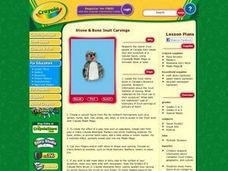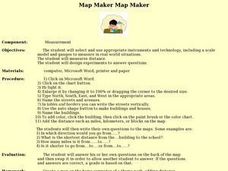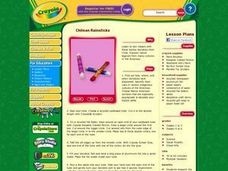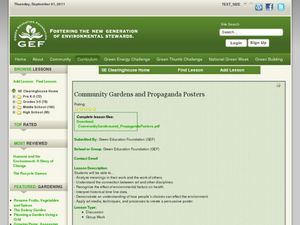Curated OER
Stone & Bone Inuit Carvings
Students research information about Canadian Inuit history, geography, and culture. They study many forms of art created by the Inuit, including sculpture with stone, animal bones or teeth, and other items found in their northern Canada...
Curated OER
The Periodic Table
These slides introduce the basics of the Periodic Table structure and the history and reasoning behind its organization. A useful chart on the fifth page gives the main properties and differences between metals, non-metals and...
Curated OER
Discovering Elements
A periodic table of elements displays the elements in groups ordered by when they were discovered. Click-by-click, new elements are added, resulting in an almost up-to-date chart. In order to reinforce the idea that symbols are used in...
Curated OER
Environmental Changes
High school scientists reasearch and illustrate changes in the local environment and consider relationships among agriculture, industry, economy, natural events, and social interactions. They construct a timeline to discover if there are...
Curated OER
Internet Fact Hunt at the "Fact Monster" Web Site- May #1
In this Internet fact hunt worksheet, students access the "Fact Monster" web site to answer 5 multiple choice questions. They answer US history, science, and geography questions.
Curated OER
Oswald Avery & The Search for the Transforming Factor
Five questions about the work of biochemist, Oswald Avery, are presented on this worksheet. You will need to find a reading passage, perhaps on the Internet, about his discovery, but it would be a worthwhile search. The assignment brings...
Curated OER
Unit 21 Terrariums
The history of terrariums and how to construct one are presented in this PowerPoint. Each important step aspect of terrarium care is discussed: selecting a container, drainage, soil, types of plants, and maintenance. You will want to...
Curated OER
Archaeology 101
Let's go on an archaeological dig! Here is a lesson plan that allows your young scientists to do just that! You fill up an empty water table or tray with sand, and bury miscellaneous objects. Pupils use spoons, sifters, and brushes to...
Curated OER
Map Maker, Map Maker
Map maker, map maker, make me a map! Your class can sing this tune as they work to create their own regional maps by taping paper to the wall, projecting an overhead transparency image, and tracing. Where this lesson plan intends for the...
Curated OER
Chilean Rainsticks
Students research the history of the rainstick and learn how it was originally made. They comprehend the use of the rainstick in various cultures. Students create a replica rainstick and decorate it in authentic Native American designs.
Curated OER
Dive Into Submarines
Students research the history and scientific principles of submarines. They read about living and working on a submarine and design and display a realistic replica of a submarine.
Curated OER
Art: Hovering Helicopters
Pupils research the history of helicopters and differentiate between the various models. while observing pictures of helicopters in action, they discuss their unique capabilities compared to other means of transportation. Finally,...
Curated OER
Magnificent Sphinx & Pyramid
Students research how ancient Egyptian structures were created and used. They sculpt realistic replicas of a pyramid and sphinx to demonstrate their knowledge of these famous structures. Sudents are told that Egyptian pyramids were built...
Curated OER
When Everything Old is New Again
Students imagine what it would be like if today's animals became dinosaurs, or the ancient creatures reappeared to roam the earth. They invent a dinosaur of the future. What might a futuristic triceratops look like? Students are taught...
Curated OER
Green Transportation System
Consider the effects of green transportation. In this environmental stewardship lesson, determine how transportation has changed throughout history and then collaborate to solve New York City transportation issues.
Curated OER
Gala Fiesta Jamboree
Students explore world cultures by identifying local cuisine. In this cultural analysis lesson, students read assigned text which discusses the history of food and how hunter gathering was essential to our existence. Students view video...
Curated OER
Community Gardens and Propaganda Posters
Students research community gardens. In this community garden lesson, students discover the history of community gardens and assess the benefits of locally grown food. Students create propaganda posters aimed at inviting discussions...
Curated OER
Nuclear Reactions Answers to Questions
Written to accompany another slide show available through our site, the information here gives the history and trivia connected to nuclear decay research. This slide show concentrates on the definitions and theory of nuclear fission and...
Curated OER
Earth's Atmosphere
This simple presentation sports a timeline of the last 400 million years. Click by click, the condition and developments in Earth's atmosphere appear along the timeline. This is a nifty PowerPoint that you could use as you teach about...
Curated OER
Selected Elements
This collection consists of a slide on each of the following unrelated, but fascinating elements: einsteinium, curium, radium, radon, nobelium, seaborgium, silicon, magnesium, and postassium. You will not find detailed information on the...
Curated OER
The Gas Laws
A couple of gas law charts and the history of the gas laws constitute this presentation. Notes are included for the slide that illustrates how to perform gas law calculations. This is a simple collection, a visual aid enhance to your...
Curated OER
The Mole
This compact collection of slides explains the history and use of the mole unit. Relative atomic mass, as John Dalton understood it, is explained. Avogadro's number is also introduced. The mole, or the unit for the amount of a substance,...
NOAA
Earth Origami
After reading a brief history of Carl Skalak's journey on the open waters, scholars make a three-dimensional model of the Earth out of an Origami balloon using a printable decorated as the Earth.
Polar Trec
Talk Story: A Native Way of Knowing
The steps of the scientific method examine a problem, make a prediction, and attempt to solve the problem—similar to the path most stories take. In the activity, individuals see how stories can explain natural events similar to the way...
Other popular searches
- History of Science Museums
- The History of Science
- History of Science Nuclear
- History of Science Physics
- History of Science Georges
- Ancient Science Inventions
- History and Science Fiction
- Computer Science History
- Brief History of Science
- Ancient Maya Science
- Science History
- "History of Science Museums

























